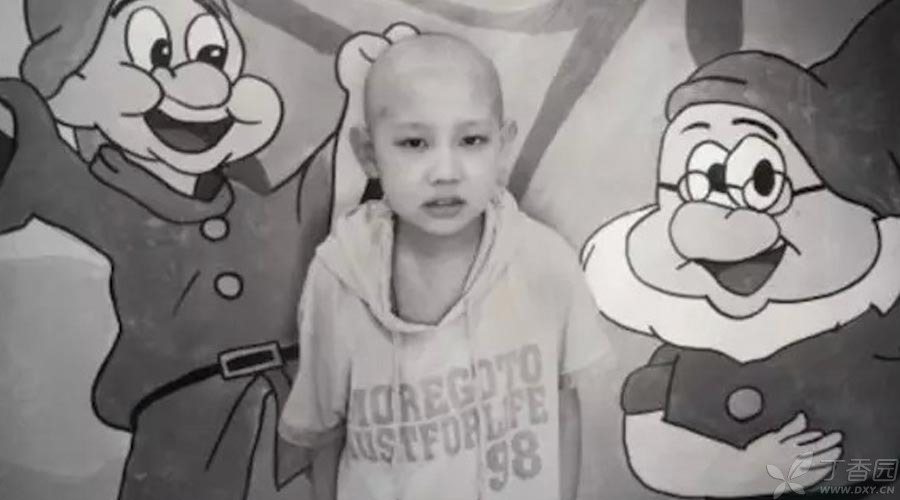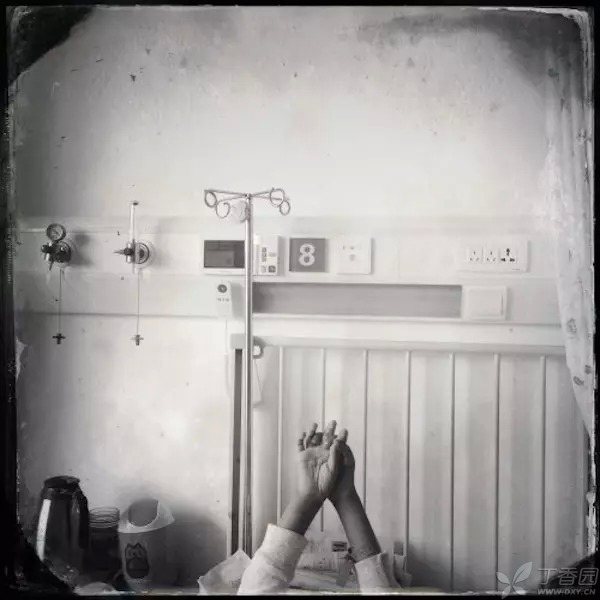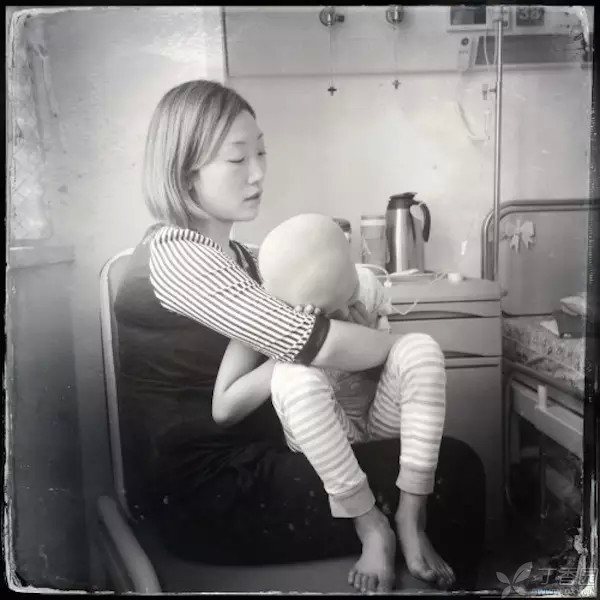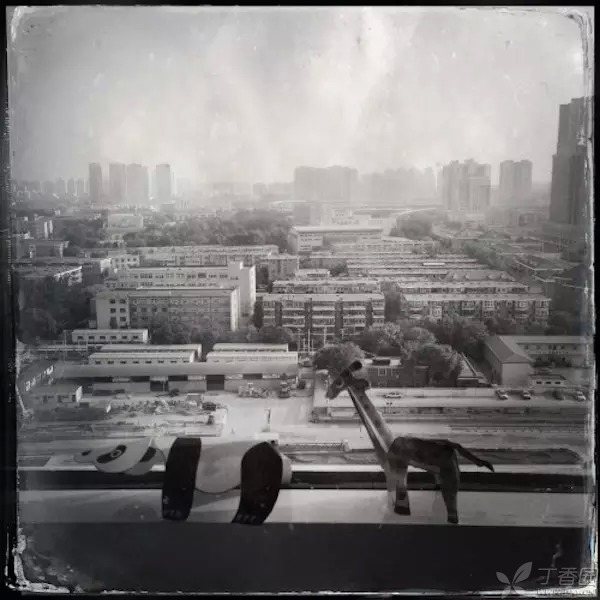
Malignant tumors have become the second leading cause of death in children. In China, children’s tumors have been neglected. However, due to insufficient cognition, misdiagnosis, lack of early screening mechanism and medical insurance coverage, the time window for children’s treatment is always missed, and the misdiagnosis rate of some diseases is even as high as 50%.
They need sunshine
For doctor Yan Jie, sunshine is a rare thing. Only when she makes rounds can she feel the sunshine coming in from the two-meter-high glass window every day. The ward is also specially dressed up to be very bright. Each room is equipped with two to five small beds 1 meter wide, covered with blue sheets with brown bears printed on them.
[Children need more sunshine.] Yan Jie said. In the children’s oncology department of Tianjin Cancer Hospital, where she works, from the chief physician to all doctors and nurses, there are no windows in the office, because the room facing south is reserved for special children.
Wen Hui, 9 years old, malignant lymphoma.
Yi Xuan, 5 years old and 8 months old, rhabdomyosarcoma.
Zheng Yi, 4 years old and 11 months old, rhabdomyosarcoma.
Huang Yixin, 1 year old and 2 months old, neuroblastoma.
… …
This is collectively referred to as children’s malignant solid tumors (hereinafter referred to as children’s tumors), because of insufficient public awareness, shortage of professional medical institutions and lack of social security, it can be described as a “dark tumor” that has been neglected for a long time.
Globally, the incidence rate of childhood tumors is about 1 in 10,000. According to the number of more than 300 million children under the age of 15 in China, the incidence rate nationwide is as high as 30,000.
It is worth noting that in recent years, the number of children with tumors in China is increasing year by year. In 2009, the former Ministry of Health issued the “China Health Statistics Yearbook”, which showed that the incidence rate of tumors among urban children (0-19 years old) in China climbed from 20.8/100,000 in 2003 to 24.7/100,000 in 2008, with both the incidence rate and the upward trend higher than those in developed countries.

No one believes that children can get this disease.
Different from adult tumors, children’s tumors mainly include brain tumors, lymphoma, neuroblastoma, hepatoblastoma, nephroblastoma, etc. These diseases mainly originate from maternal or gene defects.
Like many parents of children, Wang Lanfeng felt that he was [the most miserable mother in the world]. [Tumors were found in his stomach, eyes, legs, waist and lymph nodes.] Wang Lanfeng lovingly stroked 4-year-old Xiaokang Yu. He had the most difficult neuroblastoma to treat.
The tumor, like a small monster, raged along the neurons in Kang Yu’s body and compressed the nerves in key parts, causing damage to organ function. On the second day of admission, his leg failed, to be exact, he was completely unconscious from below his abdomen. A week later, his left eye was out of sight.
Entering the children’s oncology department of Tianjin Tumor Hospital, what I saw was the same [small bald head] as Kang Yu. At first glance, even boys and girls could not be distinguished. No matter which province they came from, the child’s experience was very similar-sudden onset, several wrong diagnoses, continuous transfer to hospital until malignant tumor was confirmed.
Before May 1, 2014, Kang Yu came back from kindergarten and cried out for leg pain. Wang Lanfeng and her husband took their children to the county hospital, but did not find out the reason. They went to the older municipal hospital. The diagnosis was [mesenteric lymphadenitis] and went home for infusion and medication.
[said the child, It doesn’t hurt so much anymore, I thought he was pretending to be ill and didn’t want to go to kindergarten.] Wang Lanfeng said. After a month, his condition took a sharp turn for the worse. The child not only suffered severe leg pain, but also had nodules in lymph nodes, which later developed to stomachache. They sent their son to the children’s hospital in the provincial capital. At this time, the doctor diagnosed it as [appendicitis] and then thought it was [mesenteric lymphadenitis].
On August 27, more than three months after the onset of the disease, Kang Yu was admitted to the Children’s Oncology Department of Tianjin Tumor Hospital and was finally diagnosed as neuroblastoma. At this time, his disease has developed to four stages, belonging to the latest stage.
This is not the only one who has been hurt by parents’ insufficient cognition and doctors’ misdiagnosis.
Zheng Taojun: Testicular endodermal sinus tumor was misdiagnosed as common mass resection and then recurred.
Huang Yixin: Neuroblastoma was misdiagnosed as psychosis (children showed [dancing hands] and [dancing feet]).
Zheng Yi: Rhabdomyosarcoma, misdiagnosed as stomatitis (tumor grows in oral cavity)…
[The misdiagnosis rate of brain tumors in children alone is 50%.] Liu Chengyong, deputy chief physician of neurosurgery at Guangzhou Red Cross Hospital, said.
Most people have not heard of these terrible diseases, and even many pediatricians have not seen such cases. Because the onset symptoms of children’s tumors are mostly fever, inflammation and abdominal pain, which are unexpected at the time of diagnosis, leading to widespread metastasis at the time of final diagnosis.
[No one believes that children can get this disease.] Almost all parents have the same reaction after hearing the diagnosis.
In fact, children are not only likely to suffer from cancer at all ages, but also from tumors in all systems of the body.

[Mom, I don’t want to die, I want to live]
Today, Xiaokang Yu is lying on a small bed more than one meter wide for chemotherapy every day. His hair has fallen off and his neck is still scarred like a map. He can’t rub it off. Tumors growing from nerves on both sides of the spine squeezed his abdominal cavity into shape and his ribs were clear.
The 4-year-old boy used to spend several hours running from east to west with his friends every day. Now, even if it weren’t for losing consciousness in his legs, overwhelming exhaustion has made him lose his vitality.
At the beginning, many parents thought of [death] in despair. On one occasion, Yang Yali was sitting on the floating window on the 15th floor of the hospital with her 6-year-old daughter Xin Jie and said to her, “This is too painful, let’s jump down.”
[Mom, I don’t want to die, I want to live.] The skinny daughter, who had lost her hair, stared at her.
The child is much stronger than imagined. Former head nurse Liu Li, who spent 18 years in the children’s oncology department, said that many important decisions were made by children to help their parents, such as removing eyeballs and amputating limbs.
Once the child has cancer, the whole family is completely changed. Parents often give up their jobs and devote themselves to the treatment of the child. The child cannot eat, feel sick and sleep with chemotherapy, and the accompanying parents do not eat or sleep. There is a blue chair that can be unfolded beside each hospital bed, and some parents sleep for several months.
No one can accurately describe the pain of the disease, and parents can only do their best to resolve it. Defoe, 7, his father kept pinching his legs for six hours after his waist was worn. Eno, 3, ‘s father shaved himself after his daughter began to lose her hair.
Sometimes, [everything that comes with death is often more suffocating than death]. Some parents divorce after their children leave. Some have changed to live in cities. Some have been slow to get out of the shadows.
At two or three o’clock in the middle of the night, nurses in the children’s oncology department always receive some [late-night calls] from parents who lost their children.
The father of a four-year-old boy could not walk out after the child went.
[He always said that when the child left, his body was rotten, he knew he was no longer able to do it, and he didn’t shout at me. In the last sentence before leaving, he still hoped that I would be with his mother…] Nurse Peng Ying said that the couple finally divorced, but the scene of the child’s deathbed was repeated by his father like a movie, and it was better to cry after that.
[The child is too poor. Why didn’t I get the disease? This is what all the parents of the children say over and over again.
However, this sentence also shows that people are not ready for these malignant tumors, which only children suffer from, from cognition to diagnosis, treatment and even medical insurance.

Missed Time Window
Broadly speaking, children’s tumors include blood tumors (leukemia) and solid tumors. However, the general feeling of children’s oncologists is that people only know about childhood leukemia but have not heard of solid tumors.
In fact, according to WHO statistics, malignant tumors have become the second leading cause of death for children, second only to accidental injuries. [Leukemia accounts for about 30%, and the rest are central system tumors (brain tumors) and other solid tumors.] Yan Jie said.
Unlike adult tumors, childhood tumors progress very fast, and it takes only three months at the earliest to develop from phase I to phase IV. Therefore, early detection is crucial.
Yan Jie remembered, When Sanlu milk powder incident occurred in 2008, local governments let local children do B-ultrasound examination of kidney stones free of charge. As a result, many children were accidentally found to have early tumors. That year thus became the most intensive period of diagnosis of children’s tumors in the country. Some doctors therefore suggested that children should also have regular physical examination, and many early tumors can be found only through relatively safe B-ultrasound.
[At that time, 9 cases of neuroblastoma in the first stage alone were found, and the therapeutic effect was very good.] Yan Jie said, but over the years, there have been no patients in the first stage, and the patients received are basically advanced.
However, even if the diagnosis has been made, most parents of children will be stranded due to the shortage of professional medical institutions-they will face a group of doctors without any pediatric experience when sent to the oncology department of a general hospital. When sent to the Department of Internal Medicine and Surgery of Children’s Hospital, doctors can only treat head with headache and foot with pain, and are helpless in dealing with malignant tumors, especially metastasis and recurrence.
5-year-old and 8-month-old Yi Xuan suffered from malignant rhabdomyosarcoma. Because some hospitals can operate on children and cannot perform radiotherapy and chemotherapy, some can perform radiotherapy and chemotherapy and cannot perform surgery. She received chemotherapy in Beijing Tongren Hospital, then went to the capital pediatric research institute for surgery, and transferred to 307 hospital for radiotherapy. After relapse, she passed through and came to Tianjin Tumor Hospital.
During the referral, the [time window] for children’s tumor treatment was missed again and again.
What does not match China’s huge population of children’s tumors is that at present only Tianjin Tumor Hospital and Sun Yat-sen University Affiliated Tumor Hospital have set up children’s oncology departments.
Because childhood tumors can occur anywhere in the body, Need the cooperation of multiple departments, Treatment is difficult. Even Zhongshan Tumor Hospital, Because of professional restrictions, encounter special bone tumors and ophthalmology, head and neck tumors will also refer children to the corresponding hospital for treatment. Secondly, children’s radiotherapy and chemotherapy are quite different from adults, and most hospitals’ radiotherapy departments are unwilling to accept pediatric cases. Sun Xiaofei’s department also specially invited a fixed doctor to do chemotherapy for children every week.
Luo Xuequn, director of pediatrics in the First Affiliated Hospital of Sun Yat-sen University, has also seen many adult tumor departments receive cases of children’s tumors. This is very outrageous in his view. It may also delay the illness. Unlike adult cancer treatment, children are sensitive to chemotherapy drugs, and the dosage and time of drugs are different from those of adults. Generally, chemotherapy is used to reduce the tumor before surgical removal.
This is a typical problem of unbalanced development of China’s medical system-diseases with low incidence rate, no money, high consumption of medical resources and long course of disease are not taken seriously.
Why not invest in curable tumors?
Solid tumors in children, the most common are various [blastomas], including neuroblastoma, nephroblastoma, hepatoblastoma and retinoblastoma.
The mother cell is a cell that can differentiate into all cell types of the organ or tissue. Once the cell mutates, with the growth of children’s age, the mutated DNA will develop into tumors in some special parts as the functions of various parts of the body of the larvae are perfected. People commonly call it [brought from the mother’s womb].
Park Fengyuan, a professor of basic medicine at Dalian Medical University, pointed out after combing several articles in the United States < < Environmental Health Perspective > > that besides family heredity, children’s tumors are related to parents’ long-term exposure to chemicals or radiation. Some studies have also shown that environmental risk factors such as exposure to radiation, chemicals and heavy metals during pregnancy are closely related to the occurrence of tumors in future generations.
Zhao Qiang, vice president of Tianjin Cancer Hospital, is one of the authorities in the treatment of children’s cancer. In his view, adult cancer can hardly be cured after spreading, but children are very sensitive to chemotherapy drugs, and quite a few can still be cured after cancer spreads.
Unfortunately, this concept is very little known. A considerable number of children who have hope of cure have been mercilessly sentenced before the time window closes. Many patients have been [kindly warned] by doctors-[your children are like this, do you still treat them? Let’s have another one.]
In fact, some childhood tumors can be completely cured. The cure rate is also much higher than that of adults. According to the data of Tianjin Tumor Hospital in the past three years, the cure rate of the most common malignant lymphoma is 85%, the cure rate of neuroblastoma is 55%, and the cure rate of rhabdomyosarcoma is 75%. The cure rate of malignant germinoma and nephroblastoma is above 90%. (Note: This cure rate is the clinical cure rate, also known as the five-year survival rate.)
Acute lymphoblastic leukemia, Hodgkin’s disease and nephroblastoma in children have been regarded as [malignant tumors that can be treated]. Nurse Peng Ying has a photo collection of children over the years in her office. Some of the cured children went to college, some worked and some went abroad.
What makes children’s oncologists feel even more difficult is that due to lack of attention, the medication and instruments for children’s oncology are [half beat slower] than those for adults.
According to Yan Jie, taking the anti-GD2 antibody for the treatment of neuroblastoma as an example, the United States has used it for many years and the therapeutic effect is obvious, but China has not approved its entry. In contrast, new drugs for adult tumors enter the Chinese market much faster.
[We know that there have been a lot of progress, many good methods and new methods abroad.] Yan Jiegang attended the 8th China Cancer Academic Conference this year, which is the most discussed issue among colleagues.
Sun Xiaofei is even more pessimistic. She found that pediatric tumors have always been neglected and it is useless to write many articles calling for them. Whether it is research or project support, government departments invest in adult tumors. Because children’s tumors need chemotherapy, surgery and radiotherapy for children, involving multiple disciplines, are difficult and have a low rate of return.
[Since it is a curable tumor, why not invest? ] Sun Xiaofei did not understand.

Can free treatment be provided?
For the patient’s family, money is also a crucial issue. If the child can persist in and complete treatment, it will cost two years of centralized treatment, three years of consolidated treatment, and money ranging from 100,000 to 300,000.
This is a heavy burden for all families.
After the child got sick, Yang Yali and her husband did not work and took care of the child in the hospital all day and all night. The parents of the children in the same department are also the same. Some of them are doing odd jobs near the hospital to make money. Shengcai’s family is the most difficult. In order to save money, his father Wen Dong only eats one or two steamed buns a day, and the vegetables are also picked up from the vegetable market downstairs.
[Every child’s story can be written in a book.] Yang Yali has bitter words.
It is understood that children’s leukemia has been implemented free treatment since 2011, and all provinces and cities have been included in the scope of medical insurance reimbursement, with reimbursement rates ranging from 70% to 90%. However, the reimbursement rate for children’s malignant tumors is much less.
Sun Xiaofei said, Reimbursement for urban children is based on medical insurance for urban residents, Rural children are reimbursed according to the new rural cooperative medical system. Because the reimbursement of children’s malignant tumors belongs to the local management, the reimbursement ratio of each city is different, and reimbursement in different places can only be reimbursed to 30% ~ 40%. There are also many parents complaining to reporters at the Southern Weekend that the local medical insurance examination and approval department has not heard of this disease and thinks that it does not belong to malignant tumors and has been delayed in reimbursement.
[This is very unreasonable. The countryside has no money, but the reimbursement can only reach 30%. The less developed the economy, the lower the reimbursement rate.] Sun Xiaofei was puzzled.
Because of the particularity of childhood cancer, a large number of imported drugs are needed, but many of them cannot be reimbursed.
Not only tumor drugs, but also a large sum of money in treatment is spent on anti-inflammatory and anti-infection. Children have low immunity and are extremely vulnerable to infection after radiotherapy and chemotherapy, while an anti-inflammatory treatment costs tens of thousands or even 20,000 to 30,000 yuan.
[We often discuss that this medicine is relatively expensive and the children’s family cannot reimburse it. What should we do? [Luo Xuequn saw that some children were half treated, because they had no money to leave, which was very uncomfortable. As a doctor, they had to help find people to raise money everywhere.
It is not easy to raise funds. Leukemia has a special [little angel fund] to help children, but there are few institutions that specifically raise funds for children’s solid tumors. Medical staff and others say nephroblastoma, rhabdomyosarcoma, Ewing’s sarcoma, etc. They don’t know it at all. They think it is a tumor and don’t want to donate it.
In contrast, In the United States, The new health insurance law already stipulates that young people and children under the age of 26 who are not covered by health insurance are included in their parents’ health insurance plans. Therefore, children with children’s tumors can fully enjoy their parents’ health insurance reimbursement. They also have special children’s cancer organizations, including the World Pediatric Oncology Association (SIOP) and the American Children’s Oncology Collaboration Group (COG), to help patients recover.
At present, Sun Xiaofei feels that the most urgent thing is to set up a children’s cancer center, There are both clinical and scientific research. China has a large population and the number of children suffering from tumors is obviously higher than that of other countries. If we want to cure more patients and have a deeper understanding, we must have our own research. At present, the state has invested too little and doctors are struggling to cope with patients and have no time to do scientific research. We can only treat them as we treat them abroad.
On October 1, 2014, National Day, the ward was much quieter than usual. Many children chose to go home and rest for a few days before coming back.
Kang Yu’s phase of chemotherapy was just over. His mother bought him an infant cart and pushed him home as he did when he could not walk. Yang Yali put on a wig for her daughter and took photos of eight children in the ward, which she posted on WeChat’s circle of friends. [They need happiness.] She wrote.
(In order to protect the rights and interests of minors, the children in this article are pseudonyms. Hu Yan of Tianjin Tumor Hospital also contributed to this article)
Southern Weekend Reporter Yuan Duanduan
Photography Zhang Tao
